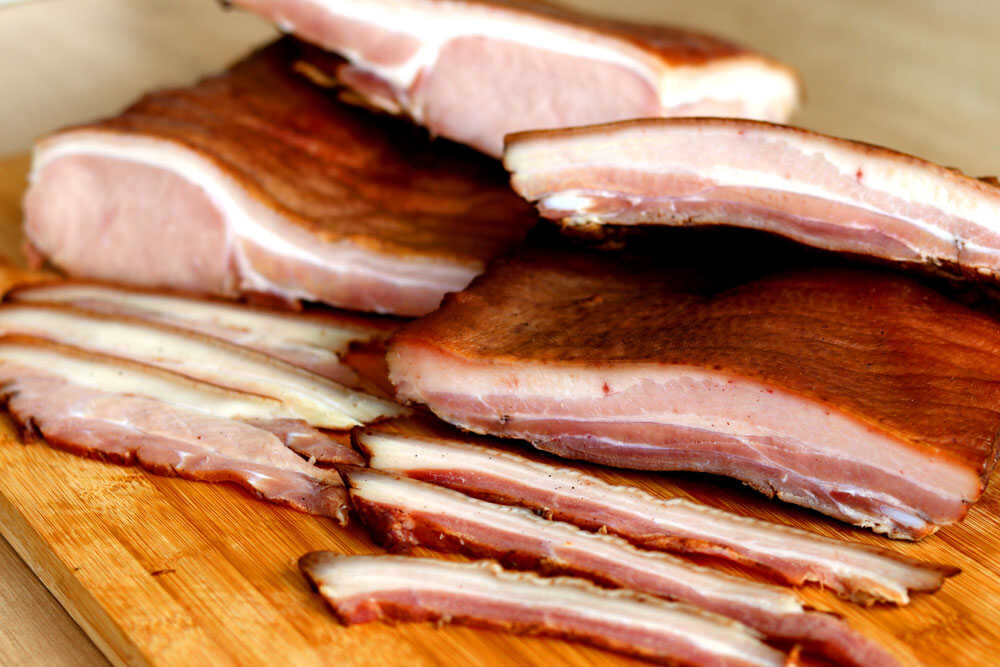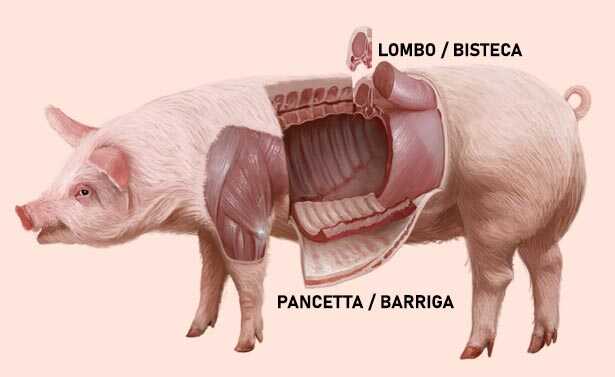
O bacon se origina de um corte suíno inteiro chamado pancetta, que é delimitada por quatro cortes que lhe conferem um formato retangular: um superior, ao longo da espinha dorsal; outro inferior, do peito e da barriga; outro anterior, que vai da extremidade da copa-lombo e termina na ponta do esterno; e o último, posterior, que continua pela extremidade do presunto e vai até o pernil. Desse corte, remove-se o couro, que é constituído de duas capas: uma camada de carne misturada com gordura e uma capa de gordura.
Um nível regular de sal no bacon varia de 1,6% a 2% do produto final, sendo que é necessário calcular a quantidade de sal que está na salmoura, para se obter este percentual no produto final.
Os fosfatos também estão entre os ingredientes que geralmente são adicionados à formulação e têm uma função importante na retenção de água, fazendo com que a carne retenha água de forma estável e oferecendo uma palatabilidade de suculência e muito sabor no bacon. Sua quantidade varia entre 0,3% a 0,5% em relação ao produto final.
Outro ingrediente necessário são os nitritos na forma de sais de cura, que oferecem sabor e coloração e evitam o crescimento de Clostridium botulinum. A regulamentação sanitária estabelece que 150 ppm (mg/kg) é o limite máximo no produto final e, por este motivo, deve-se fazer um cálculo com base nos nitritos que contêm nos sais de cura.
Dúvida sobre o sal de cura? Leia o post Sal de cura o que é e quanto usar
Depois que os ingredientes são aplicados, as pancettas são massageadas/tombadas, procede-se a um descanso de 24 a 48 horas, para que a pancetta seja curada e seja garantida uma homogeneidade completa dos ingredientes na carne e na gordura.
O tratamento térmico (defumação e coção) transforma a pancetta em bacon. A etapa inicial é pendurar as pancettas em ganchos. A pancetta deve ser fixada no gancho. Esses ganchos são pendurados no forno, no qual se faz, inicialmente, uma secagem a temperaturas de 65°C, por 20 minutos, e umidade relativa zero. Essa secagem é realizada com o objetivo de “fechar os poros” e, desta forma, obter melhores rendimentos cárneos. Depois, o produto é borrifado com fumaça líquida por dez minutos e então faz-se uma nova secagem, a 65°C, por 15 minutos, para fixar a fumaça e a coloração.
Depois da secagem no forno, aumenta-se a temperatura para 80°C e eleva-se a umidade relativa até alcançar 70°C no ponto frio.
Assim que o produto sai do forno, passa por uma ducha fria de água potável, para diminuir a temperatura para 37°C e, posteriormente, o bacon é levado para câmaras frias nas quais deve-se alcançar 4°C em menos de 24 horas, para garantir a inocuidade do bacon. Deve-se continuar diminuindo a temperatura até -4°C, para dar prosseguimento ao fatiamento, que é feito em fatiadoras automáticas. É importante indicar que a escolha da temperatura de corte dependerá da rapidez e eficiência das lâminas da fatiadora. Os tempos de parada e a potência da máquina repercutem na eficiência do processo e nos custos. Portanto, esses são fatores que fazem a diferença quanto à competitividade. Depois de fatiado, o produto passa pela termoformadora, para ser embalado a vácuo e ficar pronto para armazenamento e distribuição.
Veja também: receita de bacon defumado feito em casa







